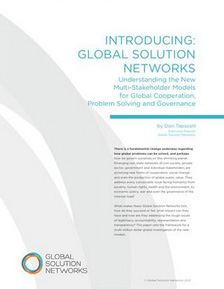 If there is a musical metaphor for the new enterprise it’s not the military band, or the symphony, it’s jazz.
If there is a musical metaphor for the new enterprise it’s not the military band, or the symphony, it’s jazz.
In a two-part session Don Tapscott explains that both the new enterprise and jazz are based on similar principles. He then brings a world-class jazz group onto the stage and performs with them (playing keyboards) will interacting with the band members to explain how a subset of these principles work in a jazz ensemble.
The 10 principles are:
- Global view. Jazz has no country. It harnesses diversity.
- Porous boundaries. Jazz gigs and productions mix and match professionals that move inside and outside ensemble boundaries.
- Value Innovation. Jazz in all about innovation, creating something new. The best innovations are disruptive – that create an entire new genre. Creativity drives jazz.
- Intellectual property. Jazz is an innovation commons. Jazz musicians have a portfolio of IP – some closed (e.g. copy written songs) and some open (solos, chord structures, other elements) that others are encouraged to use.
- Modus Operandi. Unlike a hierarchical symphony, marching band or choir jazz is a peer to peer mode more than it is hierarchical. Musicians collaborate each with their own area of authority. There may be a strong leader who is the ultimate arbitrator, not unlike in an open source community.
- Processes. Jazz follows clear processes, that are visible and well understood by all players. There is a key, time, structure, melody, harmony, lyrics, solos, counter rhythms, syncopation, rifts. Take Five in E Flat, horns, drums, keys solos – refers to a song written by Dave Brubek written in 5-4 time with a bridge played twice with solos played by specific instruments. Rather than being hardwired like symphony jazz uses re-useable and re-configurable modules and sequences then for the combined effect as appropriate.
- Human and Knowledge Capital. The foundation of good jazz is strong knowledge and expertise by individual musicians who openly share this knowledge with others in an ensemble or band. Hoarding knowledge is an offense that will get you kicked out of band. Knowledge and musical capability is viewed as an infinite resource that is realized and translated into art through not just personal mastery but collaboration.
- Information Liquidity. Jazz is transparent. Each musician knows what the other is doing and listens to them. There is no place to hide. Trust is established when individuals are considerate of the interests of fellow band members and abide by their commitments – ranging from showing up for gigs to playing the right chords at the right times. Jazz involves vulnerabilities – there is no place to hide. If you’re not a good value creator, or team player everyone knows. Jazz musicians are naked – and if you’re going to be naked, you better be buff.
- Experiences. Jazz is not a product or service. The goal is to create and experience for the musicians and more important the listeners. If things go well musicians can create a transformations – as happened at the first Monterey Jazz Festival, or when Jane Bunnett brought a collections of Cubans to North America to create a new jazz idiom.
- Technology. Jazz required good tools, but more. There are no silos – jazz interoperates. Jazz consists of activities that result in what could be called service functions (outputs) – what musicians do, not how they do them. Jazz is based on clear standards – including the foundations of music built over centuries and millennia – regarding how elements work together. These include the building blocks such as principles of harmony but extend to complex compositions that become standardized – “jazz standards.”
Image courtesy of Open City @ CKX (Photo by Dave Chidley)





